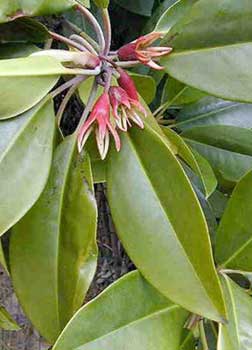|
Joñ (Bruguiera gymnorrhiza - Rhizophoraceae)
|
Description: Although joñ may grow as tall as 25 m (80 ft) or more in favorable habitats on some other Pacific Island groups, it does not reach this height in the Marshall Islands. Joñ, the black mangrove, has a buttressed trunk and knobby breathing roots (pneumatophores) that spread out over the muddy soil in which the tree grows. These knee-like breathing roots stick out above the mud during low tides and allow the plant to take in oxygen in swampy soil. Joñ produces attractive, long-lasting, red to yellow flowers about 2.5-4 cm (1-1.5 in) in length. The fruits, which germinate while still attached to the "mother" plant (vivipary), grow to be 15-35 cm (6-14 in) long before becoming detached from the trees and falling into the water, mud or sand below. |
Uses: This mangrove tree has many uses in Micronesia. Timber from joñ is very durable and is used as house posts. Poles of joñ wood can be put directly in soil that is often moist because they will not rot; the hard wood of other related mangrove trees, such as eoeak or buļaboļ ( Rhizophora sp.), will rot under those soil conditions. Smaller logs of joñ are used as house rafters. Joñ also furnishes fuel as firewood. Sometimes the wood of this tree is used to build pig fences and to make handicrafts. A dark black or brown dye comes from the skin of the fruit; this dye is used occasionally today to color "blackboards" for teaching purposes. Traditionally, joñ fruit has also been used to waterproof materials such as coconut sennit cordage, as well as to strengthen fishing nets. In addition, the fruit is mixed with leaves of other plants to treat burns. |
Distribution: Joñ is a mangrove tree found in tropical, swampy coastal areas from East Africa to the Western Pacific. It grows in many water-logged soil environments of Micronesia. It is a common tree in the middle to landward parts of the mangrove swamps. Although joñ is often planted by people who have extended its distribution into various "pat" (natural or artificially excavated swampy areas), it is most likely a native plant in the Marshall Islands. Joñ has been reported from Rōnļap, Utrōk, Lae, Aelok, Likiep, Aur, Aelōñļapļap, Mājro, Arņo, Jālooj, Epoon, Namwo, Kuwajleen, Wōjjā, and others. |
|
|
| |
 |
Main Plants
|

